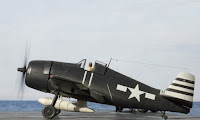People rarely pay much attention to such a thing as a fire extinguisher: this is just something that has to be handy in certain situations. However, on an air base or on an aircraft carrier deck fire extinguishers are of utmost importance, and therefore they are usually very conspicuous. That means that modellers building a diorama or a vignette can scarcely ignore this relatively unglamorous item.
In this short article I am presenting my 1/72 models of fire extinguishers used by the U.S. Navy. This is by no means an exhaustive list of all fire extinguisher types. I have only built models of those types which I could collect sufficient number of historical photographs for.
1. Portable Fire Extinguisher
This is a portable fire extinguisher of a very basic shape that was in wide use by all branches of the U.S. Military. It was seen on the U.S. Navy aircraft carrier decks throughout the 1940s and 1950s, whereas on shore bases (Navy and Marine Corps Air Stations) it served well into the 1990s.
My model comes from the Fujimi's "Flight Deck Crew & Carrier Tractor" set (cat. # 35001), but I have replaced the hose and the sprayer with scratch-built ones.
Quite recently a new set was released by Aerobonus – "U.S. Navy CO2 PSH-20 Fire Extinguishers" (cat. # 720013). It contains parts to make 6 fire extinguishers, and basing on what I see I would say that it fills the void very nicely.
2. Wheeled Fire Extinguisher
This type of peculiarly shaped wheeled fire extinguisher was in service on the U.S. Navy and Marine Corps Air Stations from the 1960s until the 1980s.
As far as I know it is not kitted yet. I used the photoetched wheels from the "Oxy-acetylene Cart" set by Brengun (cat. # 72011). The agent tanks are scratch-built from plastic and the tubular frame is made of thin metal wire.
3. Wheeled Fire Extinguisher
This type of wheeled fire extinguisher was also in service on the U.S. Navy and Marine Corps Air Stations from the 1960s until the 1980s. Apparently this was the same type of fire extinguisher (or at least a very similar externally) as the one used by the USAF.
Its 1/72 scale model can be found in the "U.S. Aerospace Ground Equipment Set" set manufactured by Hasegawa (cat. # X72-6).
When building my model I only used the tank and the wheels from the Hasegawa set. The tubular frame is scratch-built from metal wire.
4. Wheeled Fire Extinguisher
This type of wheeled fire extinguisher appeared on the U.S. Navy and Marine Corps Air Stations in the 1980s and is still in wide use today. Again, the item appears to be of the same type as the one seen on the USAF air bases.
Its 1/72 scale model can be found in the "U.S. Pilot / Ground Crew Set" set manufactured by Hasegawa (cat. # X72-7).
As before, when building my model I only used the tank and the wheels from the Hasegawa set; everything else is scratch-built from metal wire.
In this short article I am presenting my 1/72 models of fire extinguishers used by the U.S. Navy. This is by no means an exhaustive list of all fire extinguisher types. I have only built models of those types which I could collect sufficient number of historical photographs for.
1. Portable Fire Extinguisher
This is a portable fire extinguisher of a very basic shape that was in wide use by all branches of the U.S. Military. It was seen on the U.S. Navy aircraft carrier decks throughout the 1940s and 1950s, whereas on shore bases (Navy and Marine Corps Air Stations) it served well into the 1990s.
My model comes from the Fujimi's "Flight Deck Crew & Carrier Tractor" set (cat. # 35001), but I have replaced the hose and the sprayer with scratch-built ones.
Quite recently a new set was released by Aerobonus – "U.S. Navy CO2 PSH-20 Fire Extinguishers" (cat. # 720013). It contains parts to make 6 fire extinguishers, and basing on what I see I would say that it fills the void very nicely.
2. Wheeled Fire Extinguisher
This type of peculiarly shaped wheeled fire extinguisher was in service on the U.S. Navy and Marine Corps Air Stations from the 1960s until the 1980s.
As far as I know it is not kitted yet. I used the photoetched wheels from the "Oxy-acetylene Cart" set by Brengun (cat. # 72011). The agent tanks are scratch-built from plastic and the tubular frame is made of thin metal wire.
3. Wheeled Fire Extinguisher
This type of wheeled fire extinguisher was also in service on the U.S. Navy and Marine Corps Air Stations from the 1960s until the 1980s. Apparently this was the same type of fire extinguisher (or at least a very similar externally) as the one used by the USAF.
Its 1/72 scale model can be found in the "U.S. Aerospace Ground Equipment Set" set manufactured by Hasegawa (cat. # X72-6).
When building my model I only used the tank and the wheels from the Hasegawa set. The tubular frame is scratch-built from metal wire.
4. Wheeled Fire Extinguisher
This type of wheeled fire extinguisher appeared on the U.S. Navy and Marine Corps Air Stations in the 1980s and is still in wide use today. Again, the item appears to be of the same type as the one seen on the USAF air bases.
Its 1/72 scale model can be found in the "U.S. Pilot / Ground Crew Set" set manufactured by Hasegawa (cat. # X72-7).
As before, when building my model I only used the tank and the wheels from the Hasegawa set; everything else is scratch-built from metal wire.
















